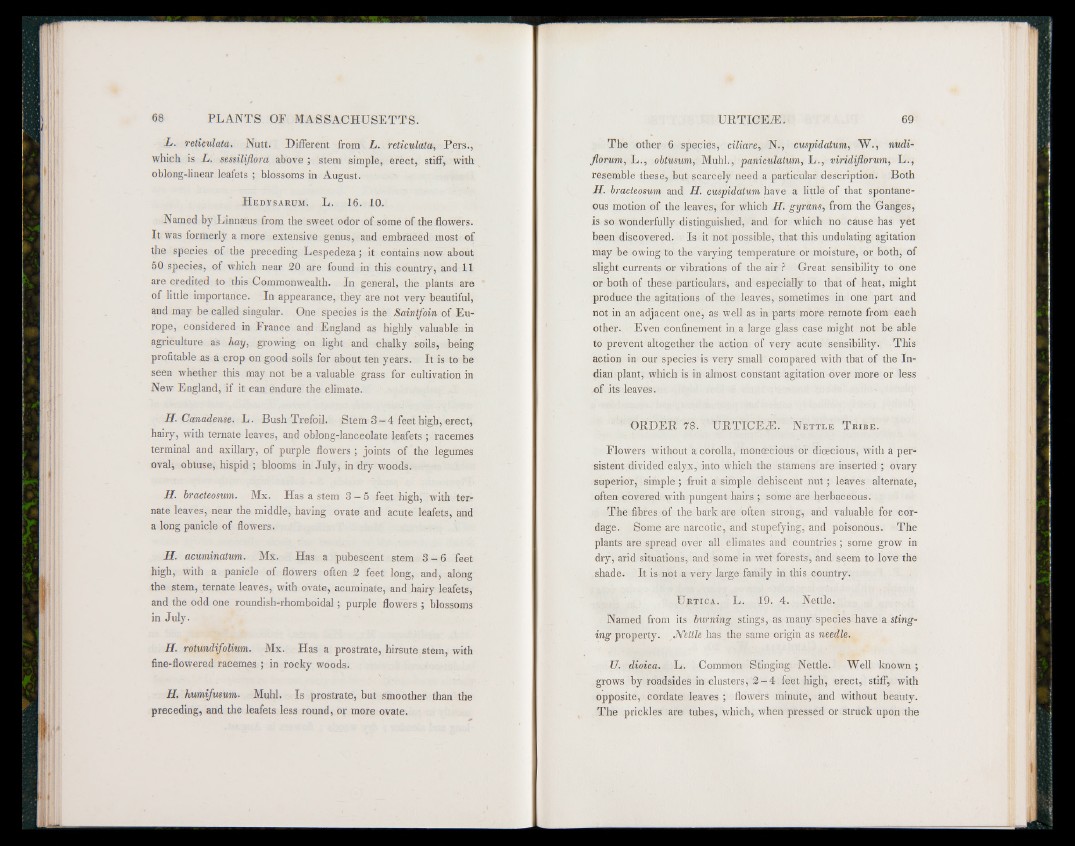
L . reticulata. Nutt. Different from L. reticulata, Pers.,
which is L. sessiliflora above ; stem simple, erect, stiff, with
oblong-linear leafets ; blossoms in August.
H edysarum. L. 16. 10.
Named by Linnseus from the sweet odor of some of the flowers.
It was formerly a more extensive genus, and embraced most of
the species of the preceding Lespedeza; it contains now about
50 species, of which near 20 are found in this country, and 11
are credited to this Commonwealth. In general, the plants are
of little importance. In appearance, they are not very beautiful,
and may be called singular. One species is the Saintfoin of Europe,
considered in France and England as highly valuable in
agriculture as Any, growing- on light and chalky soils, being
profitable as a crop on good soils for about ten years. It is to be
seen whether this may not be a valuable grass for cultivation in
New England, if it can endure the climate.
H. Canadense. L. Bush Trefoil. Stem 3 —4 feet high, erect,
hairy, with ternate leaves, and oblong-lanceolate leafets ; racemes
terminal and axillary, of purple flowers ; joints of the legumes
oval, obtuse, hispid ; blooms in July, in dry woods.
H. bracteosum. Mx. Has a stem 3 - 5 feet high, with ternate
leaves, near the middle, having ovate and acute leafets, and
a long panicle of flowers.
H. acuminatum. Mx. Has a pubescent stem 3 - 6 feet
high, with a panicle of flowers often 2 feet long, and, along
the stem, ternate leaves, with ovate, acuminate, and hairy leafets,
and the odd one roundish-rhomboidal; purple flowers ; blossoms
in July.
H. rotundifolium. Mx. Has a prostrate, hirsute stem, with
fine-flowered racemes ; in rocky woods.
H. humifusum. Muhl. Is prostrate, but smoother than the
preceding, and the leafets less round, or more ovate.
The other 6 species, ciliare, N., cuspidatum, W., nudi-
jlorum, L ., obtusum, Muhl., paniculatum, L ., viridijlorum, L .,
resemble these, but scarcely need a particular description. Both
H. bracteosum and H. cuspidatum have a little of that spontaneous
motion of the leaves, for which H. gyrans, from the Ganges,
is so wonderfully distinguished, and for which no cause has yet
been discovered. Is it not possible, that this undulating agitation
may be owing to the varying temperature or moisture, or both, of
slight currents or vibrations of the air ? Great sensibility to one
or both of these particulars, and especially to that of heat, might
produce the agitations of the leaves, sometimes in one part and
not in an adjacent one, as well as in parts more remote from each
other. Even confinement in, a large glass case might not be able
to prevent altogether the action of very acute sensibility. This
action in our species is very small compared with that of the Indian
plant, which is in almost constant agitation over more or less
of its leaves.
ORDER 78. U RT IC E iE . N e t tl e T r ib e .
Flowers without a corolla, monoecious or dioecious, with a persistent
divided calyx, into which the stamens are inserted ; ovary
superior, simple ; fruit a simple dehiscent n u t; leaves alternate,
often covered with pungent hairs ; some are herbaceous.
The fibres of the bark are often strong, and valuable for cordage.
Some are narcotic, and stupefying, and poisonous. The
plants are spread over all climates and countries; some grow in
dry, arid situations, and some in wet forests, and seem to love the
shade. It is not a very large family in this country.
U rtica. L. 19. 4. Nettle.
Named from its burning stings, as many species have a stinging
property. JVet/Ze.has the same origin as needle.
U. dioica. L. Common Stinging Nettle. Well known ;
grows by roadsides in clusters, 2 - 4 feet high, erect, stiff, with
opposite, cordate leaves ; flowers minute, and without beauty.
The prickles are tubes, which, when pressed or struck upon the